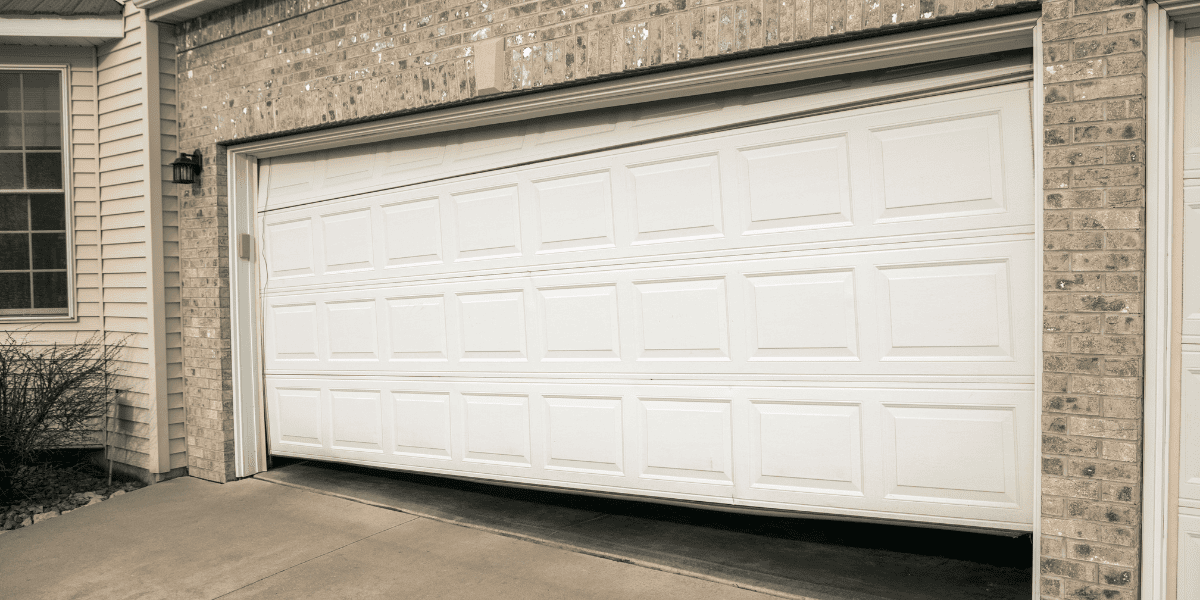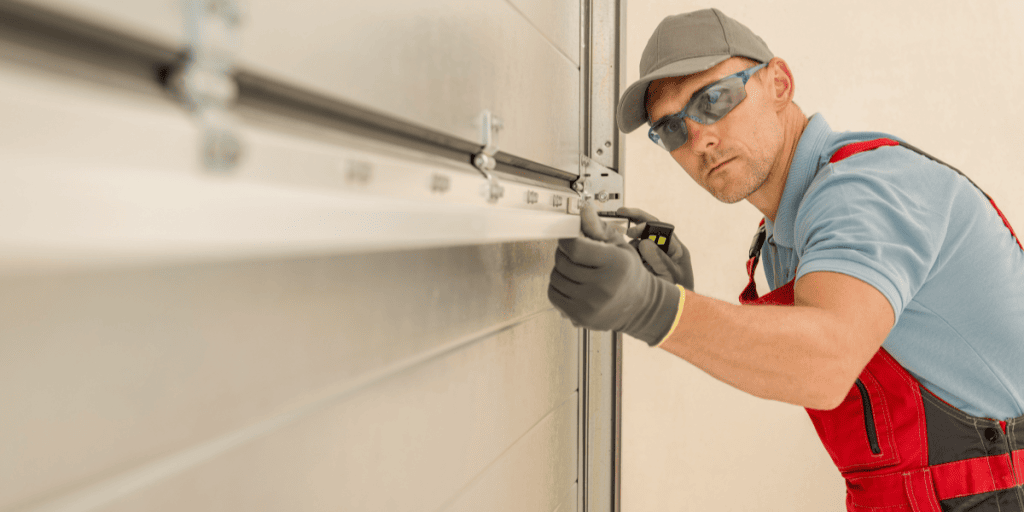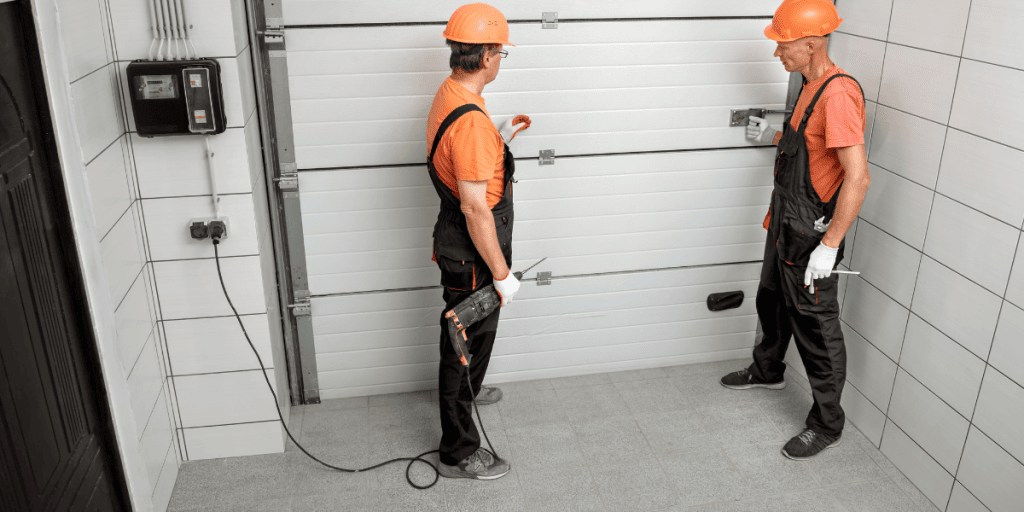Garage Door Installations on a Slope
Garage Doors on a Sloping Terrain: Overcoming Challenges and Maximizing Functionality
Garage doors are an essential component of any home, providing security, convenience, and aesthetics. However, not all homes have the luxury of a level ground for installing these doors. In this blog post, we will delve into the intriguing world of garage door installations on a slope and explore the unique challenges they present to homeowners and installers alike. Understanding the importance of proper installation in such scenarios is crucial to ensure the smooth functionality and long-lasting performance of the garage door system.
Understanding the Slope: Assessing the Terrain
When it comes to installing a garage door on a slope, properly assessing the terrain is of utmost importance. The slope’s gradient refers to the degree of incline or decline on the ground where the garage door will be installed. It is a critical factor that can significantly affect the functionality and safety of the garage door system.
- Significance of Assessing the Slope’s Gradient: Assessing the slope’s gradient is crucial because it directly impacts the door’s performance and longevity. A garage door is designed to operate smoothly on a level surface, so any significant slope can introduce challenges and potential hazards. By understanding the slope, you can make informed decisions about the type of garage door and the necessary adjustments to ensure safe and reliable operation.
- Impact on Garage Door Operation and Potential Risks: A significant slope can lead to several issues with the garage door’s operation:
- Uneven Closing and Opening: On a sloped surface, the garage door may not close or open uniformly. One side of the door may experience more friction, causing it to lag behind the other side, leading to misalignment and jamming.
- Strain on Garage Door Components: The garage door’s motor, springs, and other mechanical components may experience increased strain and wear when operating on a slope. This added stress can shorten the lifespan of these parts and lead to frequent repairs.
- Safety Concerns: A sloped surface can make it challenging to control the garage door’s descent, potentially causing it to close too quickly or slam shut unexpectedly. This poses a safety risk to people or objects in the door’s path.
- Water Drainage Issues: A sloped surface might result in water pooling near the garage door, leading to potential water damage or corrosion over time.
Tips for Measuring and Determining the Degree of the Slope Accurately
- Use a Level and Tape Measure: To measure the slope accurately, you’ll need a long level and a tape measure. Place the level on the ground, and then measure the vertical distance between the ground and the level at both ends. The difference in height will give you an idea of the slope’s gradient.
- Calculate the Slope Ratio: Divide the height difference by the horizontal distance between the two points where you measured the height. This will give you the slope ratio, which you can convert to degrees using trigonometry.
- Digital Level or Smartphone Apps: Alternatively, you can use digital levels or smartphone apps specifically designed for slope measurements. These tools can simplify the process and provide precise readings.
- Seek Professional Assistance: If you are unsure about the accuracy of your measurements or the implications of the slope on the garage door installation, it’s best to consult a professional garage door installer. They have the expertise to assess the terrain correctly and recommend appropriate solutions to ensure a safe and efficient garage door system.
Selecting the Right Garage Door: Factors to Consider
Installing a garage door on a sloped terrain presents unique challenges and considerations that need to be addressed to ensure the door’s functionality, safety, and aesthetics. When selecting the right garage door for a sloped installation, several factors come into play to ensure a successful and satisfactory outcome.
Different Types of Garage Doors and Suitability for Sloped Terrain:
- Sectional Garage Doors: Sectional doors consist of multiple horizontal panels that slide up and overhead along tracks. These doors are a popular choice for sloped terrains because they offer flexibility in design and can be adjusted to fit various garage openings. The panels’ individual movement allows the door to follow the slope’s angle smoothly.
- Roller Garage Doors: Roller doors consist of horizontal slats that roll up and down around a drum above the opening. They are well-suited for sloped installations due to their compact design and ability to fit into limited spaces, making them an ideal choice for garages with limited headroom on slopes.
- Side-Hinged Garage Doors: These traditional doors swing open and close like regular doors. While they are not as common for sloped terrains, they can still be an option if the slope allows for the door’s full range of motion without obstruction.
- Pivot Garage Doors: Pivot doors rotate on a pivot point, allowing them to swing outwards and upwards. These doors can be suitable for certain sloped installations, but the slope angle needs careful consideration to avoid any interference with the surrounding structure.
Importance of Choosing a Door that Complements the Slope’s Characteristics:
The slope’s characteristics play a crucial role in the selection process. A garage door that complements the slope ensures proper functionality and enhances the overall appearance of the property. Here are some key points to consider:
- Clearance: Measure the available space on the slope to determine the maximum height and width the garage door can have without any obstructions. This ensures the door operates smoothly and does not get stuck.
- Aesthetics: The garage door’s design and material should harmonize with the overall architecture of the house and landscape. A well-chosen door can add value and curb appeal to the property.
- Insulation: Consider the insulation properties of the door material, especially if the garage is attached to the house. Proper insulation helps maintain a comfortable temperature inside the garage and improves energy efficiency.
- Weather Resistance: If the sloped location is exposed to harsh weather conditions, such as strong winds or heavy rain, choose a garage door with appropriate weatherproofing features to protect the interior of the garage and its contents.
Factors to Consider for Sloped Installations:
- Material: Garage doors come in various materials such as steel, aluminum, wood, and fiberglass. For sloped installations, lightweight materials like aluminum or fiberglass can be beneficial as they put less stress on the door’s operational mechanisms and tracks.
- Design and Color: The door’s design and color can significantly impact the overall aesthetics of the property. Consider selecting a design that complements the slope and the surrounding landscape. Earthy tones and natural finishes can work well in such settings.
- Operational Mechanism: Each type of garage door has a specific operational mechanism, and the slope may influence which mechanism works best. For instance, roller doors are ideal for limited headroom situations on slopes, while sectional doors are versatile and can fit various sloped openings.
- Professional Installation: Installing a garage door on a slope requires precise measurements and expertise. It’s essential to hire professional garage door installers experienced in working with sloped terrains to ensure a seamless and safe installation.
Site Preparation: Leveling and Foundation
Proper site preparation is crucial when installing a garage door on a slope to ensure the stability and functionality of the door system. A level foundation is essential for the smooth operation of the garage door, as any slope or unevenness can lead to various issues, such as misalignment, binding, and premature wear and tear on the components.
Importance of Proper Site Preparation:
- Door Alignment: A sloped foundation can cause the garage door tracks to be misaligned, making it difficult for the door to open and close smoothly. This misalignment puts extra strain on the door opener, potentially leading to its failure.
- Door Balance: Garage doors rely on a balanced system for proper functioning. An uneven foundation can disrupt this balance, causing one side of the door to be heavier than the other. This imbalance not only affects the door’s performance but also poses safety hazards.
- Weather Seal: An uneven foundation can create gaps and spaces around the garage door, compromising the effectiveness of weather sealing. It may allow water, debris, or pests to enter the garage, affecting the contents inside.
Methods to Level the Ground:
- Concrete Pads: One of the most effective ways to level the ground is by pouring concrete pads or footings at strategic points along the slope. These pads act as a stable base for the garage door tracks and opener, ensuring a level surface for the door to operate.
- Leveling Kits: Garage door installation professionals can use leveling kits that include shims and adjustable brackets. They can be placed under the tracks to compensate for the slope and achieve a level surface.
- Grading: In some cases, minor slopes can be corrected by regrading the area surrounding the garage. This involves removing or adding soil to create a more level surface.
Addressing Drainage Issues:
Drainage problems can exacerbate the issues related to a sloped foundation. Improper water flow around the garage can lead to water pooling near the door, causing potential water damage and compromising the door’s components.
Mitigation methods for drainage issues:
- French Drains: Installing French drains around the perimeter of the garage can redirect water away from the foundation. These drains consist of a trench filled with gravel and a perforated pipe to efficiently channel water away from the garage.
- Rain Gutters: Installing rain gutters on the roof of the garage helps collect rainwater and direct it away from the foundation. Downspouts should be properly positioned to ensure water is carried away from the garage area.
- Grading Adjustment: As mentioned earlier, regrading the area can not only level the ground but also help direct water away from the garage. Proper grading ensures that water flows away from the structure, reducing the risk of water-related issues.
Adapting the Garage Door Tracks:
Installing a garage door on a slope requires special attention to ensure the door functions properly and smoothly. The slope’s angle can significantly impact the garage door’s operation, making it essential to adapt the tracks accordingly.
- Adapting the Garage Door Tracks: The need to customize the tracks arises from the fact that the garage door needs to travel along a consistent path as it opens and closes. On a level surface, standard horizontal tracks are sufficient for guiding the door smoothly. However, on a slope, these tracks would not align with the door’s movement, leading to potential misalignment, friction, and uneven operation.
To address this, the tracks must be adjusted to match the slope’s angle. This customization ensures that the garage door maintains a proper and even clearance from the ground and sides throughout its travel, preventing it from getting stuck or scraping the floor.
2. Vertical, Low-Headroom, or High-Lift Track Configurations: Different slope gradients may require various track configurations to suit the specific situation. The choice of track configuration depends on the amount of slope and the available headroom in the garage.
-
- Vertical Track Configuration: This setup is suitable for moderate slopes. Vertical tracks run vertically on the garage wall, ensuring the door follows a consistent path up and down the slope. A properly installed vertical track system allows the door to maintain stability, minimizes strain on the door opener, and prevents undue stress on the door panels.
- Low-Headroom Track Configuration: When dealing with steeper slopes, the headroom available for track installation becomes limited. In such cases, a low-headroom track configuration is ideal. These tracks are specially designed to reduce the space required between the top of the door opening and the ceiling, allowing for proper door movement even with limited vertical clearance.
- High-Lift Track Configuration: In situations where the slope is substantial, and additional headroom is necessary, a high-lift track configuration is the best choice. This setup combines vertical and horizontal tracks to lift the door higher before it starts its horizontal movement, providing the required clearance without compromising on smooth operation.
3. Precision and Accuracy in Track Adjustments: Proper track adjustments are crucial to the successful installation of a garage door on a slope. Precision and accuracy are paramount during this process to prevent misalignment, which could lead to operational issues and potential damage to the door.
Improperly aligned tracks can cause the door to bind, jam, or come off the tracks entirely. Additionally, misaligned tracks may exert unnecessary strain on the garage door opener, reducing its lifespan and increasing the risk of malfunction.
To ensure precision, it’s recommended to seek the assistance of a professional garage door installer with experience in dealing with sloped surfaces. They have the expertise and tools to make accurate adjustments, ensuring that the door glides smoothly and safely along the slope.
Professional Installation: Why It Matters
When it comes to installing garage doors on a slope, the complexities involved demand the expertise of a professional installation service. While DIY projects can be rewarding, attempting to install a garage door on a sloped surface poses unique challenges that can lead to potential risks and void warranties. Here’s why opting for professional installation matters:
- Understanding Slope Dynamics: Garage doors on flat surfaces follow a straightforward installation process, but slopes introduce variations in the dynamics. Professional installers have the knowledge and experience to assess the slope’s gradient accurately, ensuring the door operates smoothly without any obstructions or issues.
- Customization and Precision: Sloped garage door installations require precise measurements and customization to fit the unique contour of the terrain. Professional installers can accurately measure and craft the door to guarantee a perfect fit, maximizing functionality and aesthetics.
- Proper Alignment: Garage doors need precise alignment to function optimally and ensure proper sealing. On a slope, maintaining alignment becomes even more crucial, as any misalignment can lead to gaps or difficulties in opening and closing the door. A professional installation team can guarantee the door is aligned correctly for smooth operation.
- Safety Considerations: Garage doors are heavy and can pose significant safety risks if not installed correctly. On a slope, the potential for accidents increases if the door is not properly balanced and secured. Professionals are trained to follow safety protocols during installation, reducing the likelihood of accidents and injuries.
- Impact on Warranties: Many garage door manufacturers offer warranties on their products, but these warranties may be voided if the door is improperly installed. Choosing professional installation ensures that the door’s warranty remains intact, providing peace of mind and protection against unexpected repair costs.
- Expert Knowledge and Tools: Professional installers have access to specialized tools and equipment required for slope installations. These tools allow them to handle the unique challenges posed by the terrain efficiently and effectively.
- Local Building Codes and Regulations: Professional garage door installation services are well-versed in local building codes and regulations. They ensure that the installation complies with all necessary requirements, avoiding potential legal and safety issues.
Regular Maintenance
Regular maintenance is crucial for all types of garage doors to ensure their smooth operation and longevity. However, when it comes to garage doors installed on slopes, the importance of regular upkeep becomes even more significant. Sloped garage door installations present unique challenges due to the potential for increased stress and strain on the door components, particularly the tracks and springs.
Maintenance Checklist for Sloped Garage Door Installations:
- Lubrication: Regularly lubricate all moving parts of the garage door, including rollers, hinges, and tracks. Use a high-quality garage door lubricant to reduce friction and prevent unnecessary wear. Lubrication is especially crucial for sloped doors as it helps minimize the strain on components while opening and closing on an incline.
- Track Alignment: Check the alignment of the tracks periodically to ensure they are properly aligned and parallel to each other. Misaligned tracks can cause the garage door to operate unevenly, potentially leading to premature wear on certain areas of the door.
- Spring Tension: The garage door springs play a vital role in counterbalancing the weight of the door, making it easier to open and close. For sloped garage doors, maintaining the appropriate spring tension is essential to ensure smooth and balanced operation. It is crucial to have a professional garage door technician inspect and adjust the spring tension as needed.
- Weather Stripping Checks: Weather stripping is essential for creating a seal between the garage door and the frame, protecting the interior from the elements. Regularly inspect and replace any damaged or worn weather stripping to maintain energy efficiency and prevent moisture or debris from entering the garage.
- Sensor Calibration: For modern garage door systems equipped with safety sensors, ensure that the sensors are properly aligned and functioning correctly. These sensors prevent the door from closing if an object or person is detected in the door’s path, enhancing safety during operation.
- Regular Inspections: Schedule periodic inspections by a professional garage door technician. They can identify potential issues early on and address them before they escalate into more significant problems.
Frequently Asked Questions
Can I install a garage door on a sloped driveway?
Yes, it is possible to install a garage door on a sloped driveway. However, it requires proper planning and specialized installation techniques to ensure the door functions smoothly and safely.
Why is installing a garage door on a slope more complicated than on a level surface?
Installing a garage door on a slope is more complicated because it requires addressing potential issues related to the door’s alignment, balance, and proper clearance during operation. The slope can impact how the door moves and affects its overall performance.
What kind of garage doors are suitable for sloped driveways?
Generally, sectional garage doors or roller doors are more suitable for sloped driveways. These types of doors can roll or slide upwards without obstructing the driveway’s incline. It’s essential to consult with a professional installer to determine the best option for your specific slope and garage size.
Can I use my existing garage door on a sloped driveway?
It depends on the specific design of your garage door and the severity of the slope. In some cases, modifications can be made to adapt the existing door to the slope, but in others, it might be more practical to replace it with a door that is better suited for the slope.
Do I need to level the driveway before installing a garage door on a slope?
In many cases, it is recommended to level the driveway before installing a garage door on a slope. A level surface helps ensure the door operates correctly, reduces strain on the door components, and improves overall safety.
Conclusion
In conclusion, installing a garage door on a slope demands careful attention to detail and expertise. Professional installation and regular maintenance are key to ensuring a safe and reliable garage door system that can withstand the challenges posed by a sloped surface. By prioritizing safety and seeking professional assistance, homeowners can enjoy a functional and long-lasting garage door that provides both convenience and peace of mind. In conclusion, installing a garage door on a slope demands careful attention to detail and expertise. Professional installation and regular maintenance are key to ensuring a safe and reliable garage door system that can withstand the challenges posed by a sloped surface. By prioritizing safety and seeking professional assistance, homeowners can enjoy a functional and long-lasting garage door that provides both convenience and peace of mind.



